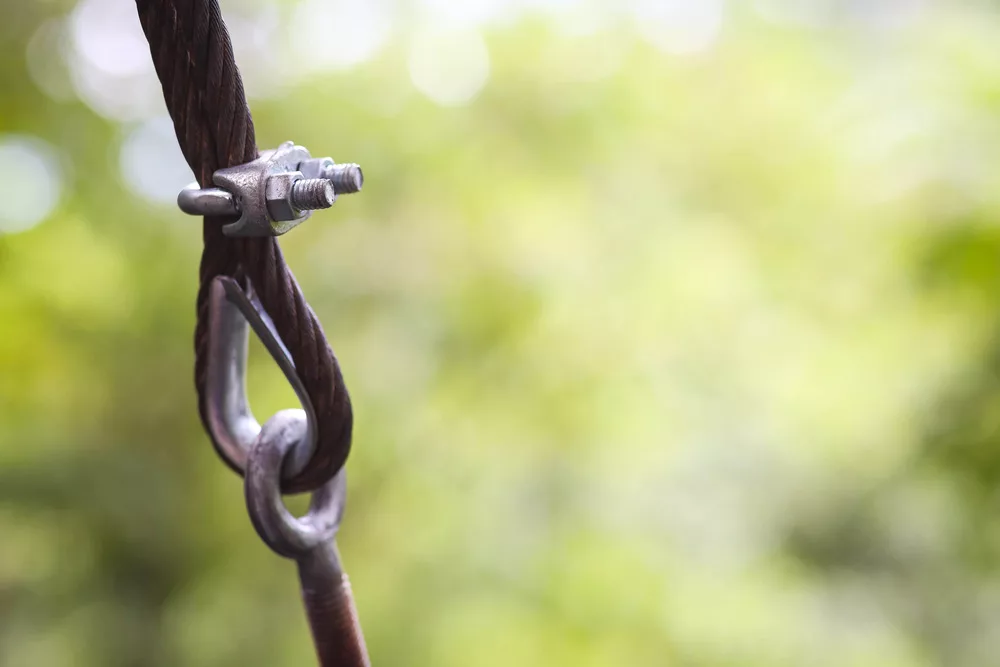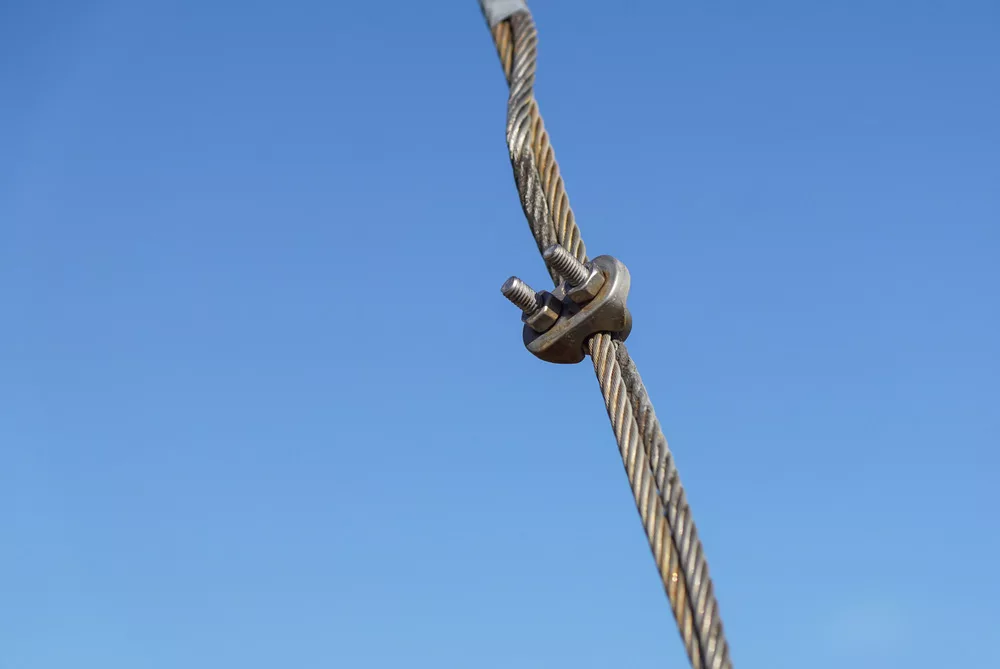Wire cables are incredibly versatile mechanical devices. And you can use them to support or move a load—whether on cranes or other lifting applications. But you’ll need to secure your ropes, and one of the most common options is clamps for wire cable.
As an end-user of wire cables, you must know the rigging components you need to attach to wires and lift a load. But don’t worry if you know little about wire rope clamps.
We’ll discuss the different types of clamps for wire cables and more in this article.
Are you ready? Let’s go!
Table of Contents
- What is a Wire Cable Clamp?
- Types of Wire Cable Clamps
- Styles of Wire Rope Clips
- Types of Wire Rope Clip Materials
- What is the Best Way to Secure Wire Ropes?
- What to Avoid when Installing Wire Cable Clips
- Wrapping Up
What is a Wire Cable Clamp?

A wire rope clip
Wire rope clamps are load-bearing eyes that you can use at the end of a cable. Further, you can use them to connect two cables with a lap splice.
In truth, wire cable clamps are simple to install when working on the field. And they offer 80% to 90% rope-breaking strength efficiency, depending on the wire cable’s diameter.
However, you can’t use wire cable clamps for making slings. Why? The ASME B30.9 Slings standard stands against using mechanical wire cable terminations needing frequent adjustments (to maintain efficiency) to fabricate slings.
But you can use wire cable clamps for the following applications:
- Running a long wire cable through a shackle or an eye bolt
- Perimeter cables on parking lots, docks, etc.
- Wire cable end termination on a winch or crane cable.
Types of Wire Cable Clamps

A clip-on wire rope
You can purchase two wire rope clips: U-bolt and dual saddle clips. Let’s get into the details.
U-Bolt Wire Cable Clamps
These wire cable clamps are the most common styles. Also, they combine a U-bolt, two nuts, and a metal saddle (base) to make one durable cable clip.
In addition, manufacturers make them from cast iron or forged steel. Unfortunately, these types require more attention and consideration during installation to avoid fatal results.
Also, there are two types of U-bolt wire cable clips available.
Forged Wire Cable Clamp
For this type, manufacturers craft the base from forged steel. As a result, they usually heat and hammer the clip into the preferred shape, giving an incredible steel-consistent grain structure.
Further, due to their tensile strength and durability, forged wire rope clips are widespread for critical, overhead, and heavy-duty loads, like winch lines, guy lines, scaffolds, crane hoist lines, support lines, tie downs, and towing lines.
Malleable Wire Rope Clips
Malleable wire rope clips are ideal for light-duty uses with small loads, like fencing, handrails, guard rails, etc. Contrary to the forged variants, these types have malleable cast iron bases that can fracture under pressure.
In addition, malleable wire rope clips are not ideal for heavy-duty use because they don’t have the beneficial grain structure of forged bases or the metal properties of steel.
Double Saddle Wire Rope Clips
As the name implies, these wire cable clamp types have double saddles, each hosting support and double nuts (one on the top and the other on the bottom). The dual saddle clips don’t have a specific direction, allowing you to install them freely on the live and dead ends of wire ropes.
Styles of Wire Rope Clips
Let’s take a brief look at the different styles of wire rope clips available on the market.
Traditional Style Wire Rope Clip
This style consists of the u-bolt, nuts, and saddle. U-bolt wire cable clamps use this style to provide a durable eye termination for heavy-duty or light-duty lifting applications.
First Grip Style Wire Rope Clip
Interestingly, the first grip style only comes with saddles and nuts. How does it work? Its design mirrors the saddles, eliminating the need for a u-bolt and providing unique advantages during installation.
Drop-Forged Wire Rope Clips
Drop-forged, traditional, & first-grip styles are the most durable and robust clips you can get on the market.
The drop-forging process enhances the steel’s grain structure with consistent and conformed levels, making them ideal for critical suspension, guying, and tie-down applications.
Cast Stainless Wire Rope Clip Styles
Cast stainless clips are the perfect cost-effective alternatives to drop-forged variants. And they are ideal for non-critical applications.
However, these clip styles are less reliable than their drop-forge counterparts because of the gap in manufacturing processes.
Types of Wire Rope Clip Materials
316 Stainless Steel
- This material offers the highest corrosion resistance, making it incredibly durable.
- 316 stainless steel is excellent for wire rope clips used in outdoor applications, especially projects in or near saltwater environments.
Hot Dipped Galvanized (HDG)
- HDG is cheaper compared to stainless steel.
- It’s also ideal for outdoor environments and applications. However, HDG materials don’t offer the same corrosion resistance as stainless steel variants.
Malleable Zinc Plated Materials
- This material type also works excellently outdoors. But malleable zinc plates are more susceptible to surface rust, primarily when you use them in snow, rain, salt air, or saltwater environments.
What is the Best Way to Secure Wire Ropes?
Follow the steps below to learn how to secure wire cables properly during your lifting application.
- First, wrap the wire rope to form the eye or around the thimble. Also, don’t forget to turn back the correct amount of cable. Usually, your manufacturer will provide the specifications for this step.
- Then, add the first wire cable clamp at the rope’s dead end with one base width of space. Further, grab a torque wrench to tighten the clip’s nuts.
- If your application requires a second clip, apply it as close to the thimble or eye loop as possible. And ensure you tighten the nuts properly.
- However, if the project requires more than two clips, arrange them with even spaces between the first two clips placed on the cable.
What to Avoid when Installing Wire Cable Clips
While it’s not rare to install wire rope clips incorrectly, it’s a situation you should avoid at all costs. With that in mind, let’s explore a few things to evade when installing wire rope clips.
Not Torquing According to the Manufacturer’s Expectations
Although you need a torque wrench to make wire ropes function properly, torquing them too much or too little can cause failures.
In short, over-torqued clips can damage the wire rope’s threads, while under-torqued ones will diminish the clamp’s holding power, allowing the cable to slip through.
Incorrect Clip Spacing
You must always keep a proportional amount of space on clips, depending on the number and size you need. Incorrect spacing can reduce the overall holding quality or cause the clips to fail during lifting applications.
Using the Incorrect Amount of Turnback when Creating an Eye
Turnback refers to the section of the wire cable’s eye running from the end of the bearing eye to the live end. Using less than the recommended turnback amount may reduce the rope eye’s efficiency, leading to cable failure.
Not Using the Suggested Number of Clips
Your rope’s diameter determines the minimum number of clips required for a lifting application. But, using less than the specified number would lead to lowered efficiency and increase the possibility of failure.
Applying the Wrong Type of Clip
Always ensure you use the correct clip type for your applications. Remember that you can only use malleable clips for non-critical projects and forged variants for critical applications.
Swapping the two types can lead to potential injury, loss of life, or property damage. As a result, it’s necessary to check your clips before installation.
Wrapping Up
Wire cable clamps are common yet essential pieces of rigging equipment. You can use them to form rope eyes or connect two cables.
But installing them requires some consideration and knowledge of the proper procedures. Moreover, incorrect installation may lead to reduced efficiency and possibly fatal accidents.
Do you have more questions? Feel free to contact us, and we’ll be happy to help.
